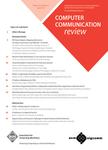版权所有:内蒙古大学图书馆 技术提供:维普资讯• 智图
内蒙古自治区呼和浩特市赛罕区大学西街235号 邮编: 010021

作者机构:Dept. of Electrical Engineering University of Southern California Los AngelesCA United States Cisco Systems Inc. San JoseCA United States Digital Enterprise Research Institute National University of Ireland Galway Ireland Dept. of Electrical and Computer Engineering University of Cincinnati CincinnatiOH United States Communication Systems Engineering Dept. Ben Gurion University of the Negev Israel
出 版 物:《Computer Communication Review》 (Comput Commun Rev)
年 卷 期:2008年第38卷第3期
页 面:17-26页
核心收录:
学科分类:0810[工学-信息与通信工程] 08[工学] 0812[工学-计算机科学与技术(可授工学、理学学位)]
基 金:The first five authors are listed in alphabetical order. All authors participated in the work described in this paper while they were a\u00B1liated with the Autonomous Networks Research Group at the University of Southern California. This work is supported in part by the National Science Foundation (NSF) under the NETS NOSS grant 0435505 and CAREER grant 0347621. Any opinions findings and conclusions or recommendations expressed in this material are those of the authors and do not necessarily reffect the views of the National Science Foundation
主 题:Structured Query Language
摘 要:In the last few years, several studies have analyzed the performance of flooding and random walks as querying mechanisms for unstructured wireless sensor networks. However, most of the work is theoretical in nature and while providing insights into the asymptotic behavior of these querying mechanisms, does not account for the non-idealities faced by the network in real deployments. In this paper, we propose a 3-way handshake protocol as a reliable implementation of a random walk and compare its performance with flooding in real environments. The metrics considered are delay, reliability and transmission cost. Our initial results suggest that flooding is better suited for low-interference environments, while random walks might be a better option in networks with high interference. We also present possible research directions to improve the performance oflooding and random walks. © 2008 Authors.